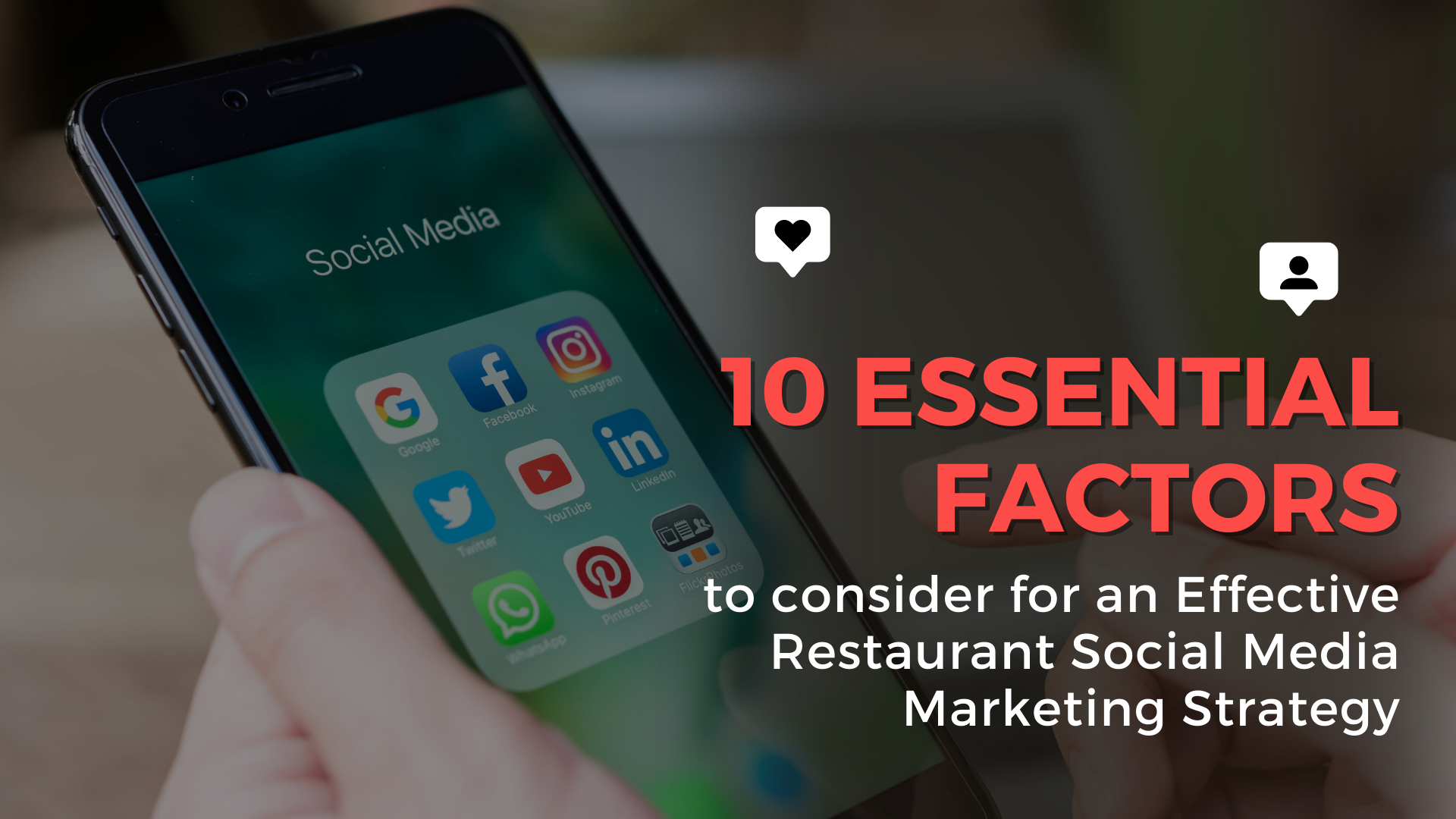The restaurant industry is a competitive one, and having an effective social media marketing strategy is essential for success. An effective strategy requires a comprehensive understanding of the various factors that will contribute to its success. In this article we’ll provide you with a comprehensive overview of the 10 essential factors to consider for an effective restaurant social media marketing strategy. By understanding these factors, restaurant owners can develop an effective strategy to maximise their social media presence, reach their target audience, and ultimately achieve their goals.
1. Identify Your Target Audience
When it comes to restaurant social media marketing, one of the most important steps is to identify your target audience. Knowing who you are trying to reach is essential for creating an effective strategy. It allows you to focus your efforts on getting the right message to the right people. To do this you might want to consider many different factors, such as age, gender, location, interests, and more. This can help you create marketing campaigns that will be more likely to resonate with the people you’re trying to reach. Additionally, you can also use this information to create targeted ads on social media platforms. This will help you get the most out of your budget and reach the right people.
2. Choose the Right Platforms
Different platforms have different audiences, so it is important to select the ones that will best reach your target market. For example, if you are targeting younger customers, you may want to focus on Instagram and Snapchat, while if you are targeting business professionals, you may want to focus on LinkedIn. Additionally, you should consider the types of content that you plan to post. Some platforms are better suited for videos, while others work better for images. When selecting the platforms for your restaurant’s social media marketing strategy, it is also important to consider the features they offer. Additionally, some platforms offer advertising capabilities, so you can reach a larger audience and drive more traffic to your restaurant. Lastly, you may want to consider how easy it is to use the platform, so the process of managing your accounts is as streamlined as possible.
3. Develop a Content Strategy
Content is what will draw customers in and keep them engaged, so it’s important to create content that is attractive and relevant to your target audience. A content strategy should include both long-term, planned content as well as short-term, reactive content. Long-term content should include items such as recipes, blog posts, and promotional campaigns that can be used to build brand loyalty and awareness. Short-term content should include items such as food reviews, customer feedback, and special offers that can be used to draw in new customers and keep existing customers engaged.
When creating content, it’s important to focus on quality over quantity. It’s better to post great content sporadically than to post mediocre content on a frequent basis. Make sure your content is engaging, informative, and entertaining, as this will help keep customers interested and engaged. Additionally, it’s important to make sure the content you post is relevant to your restaurant and the services you offer. This will help customers connect with your brand and understand that you are an authority in the restaurant industry.
4. Utilise Visual Content
In today’s digital landscape, visual content is key to effective restaurant social media marketing. Visual content such as photos and videos can help to engage followers and bring the restaurant’s story to life. Restaurants should focus on creating high-quality visual content. For example, photos should be clear and well-lit and videos should be nicely edited and eye-catching. By creating high-quality visual content, restaurants will be able to effectively engage their followers and highlight the best parts of their restaurant.
5. Leverage User-Generated Content
User-generated content can be a powerful tool for restaurant social media marketing. By leveraging content created by customers and fans, businesses can create a sense of community and connection with their followers. User-generated content can be used in a variety of ways, including incorporating it into marketing campaigns, sharing it on social media, or using it in promotional materials. To leverage user-generated content effectively, restaurants should create a hashtag and ask customers to share their experiences. Encouraging customers to post pictures of their meals or tagged reviews of their experiences will provide valuable content that can be used in marketing campaigns as well as add to the overall ambiance of the restaurant. Restaurants should also take the time to respond to comments, reviews, and posts, as this will show customers that their feedback is valued.
6. Engage with Your Audience
Developing relationships with customers can take many forms. It could be as simple as responding to tweets or comments on posts, or it could involve creating special offers or discounts for your followers. This could involve creating polls to get customer feedback and ideas, or even hosting virtual events. Whatever the approach, it’s important to make sure that your interactions are genuine, helpful, and timely. This will help to create a strong, positive relationship between you and your customers. It’s also important to stay active and consistent when it comes to engaging with your audience. Make sure to post regularly, respond quickly, and ensure that you’re providing helpful and relevant content. This will help to keep your followers engaged and interested in your restaurant. Ultimately, having a strong relationship with your customers is essential for a successful restaurant social media marketing strategy.
7. Monitor Your Performance
Keeping track of metrics such as engagement, reach, and conversions is important to identify what aspects of your strategy are working and which need improvement. By monitoring these metrics, restaurant owners can quickly identify which posts and campaigns are most successful and make adjustments accordingly. Monitoring your performance also provides a better understanding of your audience. Keeping track of which posts are the most successful can provide insights into the interests and preferences of your audience. This can be used to better tailor your content to their needs and improve engagement.
Overall, monitoring your performance is an essential part of any restaurant social media marketing strategy. It allows you to assess which strategies are working and which need improvement, gain insights into your audience, and identify any potential opportunities or threats. By keeping track of these metrics, restaurant owners can ensure that their marketing strategy is as effective as possible.
8. Take Advantage of Paid Advertising
Paid advertising is an effective way to get your restaurant’s message out quickly and to a large audience. It can help you reach potential customers who may not have otherwise heard about your restaurant, and it can help you target customers who already know about your restaurant but may not have taken action yet. When it comes to restaurant social media marketing, paid advertising can be used to great effect. For example, you can use paid ads on platforms like Facebook and Instagram to target potential customers in the local area and increase brand awareness. You can also use paid ads to promote special offers or discounts, as well as to showcase your restaurant’s unique offerings and services. Additionally, you can use paid ads to quickly drive traffic to your website or app, helping you to increase sales.
9. Analyse Your Competitors
When it comes to creating an effective restaurant social media marketing strategy, it is important to take the time to analyse your competitors. It is important to take a look at the different platforms your competitors are using, what type of posts they are sharing, and which ones are resonating most with their followers. Additionally, you should pay attention to the type of content they are creating, the frequency of their posts, and their overall engagement rate. This will give you a better understanding of the type of content and strategies that are successful in your industry.
At the same time, it is important to keep an eye on the trends that your competitors are following. Are they focusing on a specific type of content? Are they using a certain hashtag or campaign? By keeping track of these trends, you can get ahead of the curve and use them to your advantage in your own social media marketing strategy.
10. Keep Track Your Results
In order to track your results, you should have a metric-focused approach. This means that you should set specific goals for each of your campaigns and track your progress against those goals. You can track your results by analysing the number of likes, shares, comments, and other engagement metrics on your posts, as well as website traffic, brand searches, and other indicators of success. You should also track the performance of your campaigns over time in order to identify any changes or trends that may be occurring. Additionally, it is important to track the overall ROI of your restaurant social media marketing strategy. This means that you should measure how much money you are spending on your campaigns and how much revenue they are generating. By tracking your ROI you can identify which campaigns are more successful and cost-effective than others, and you can also make informed decisions about how to improve your strategies in the future.
In conclusion an effective restaurant social media marketing strategy is essential for success in the competitive restaurant industry. By taking the time to consider the 10 essential factors discussed in this blog post, restaurant owners and managers can create an effective strategy that will help to increase their presence on social media and drive customers to their business. These factors include understanding target audiences, creating content tailored to those audiences, using paid advertising to reach the right people, and responding to customer queries and reviews in a timely manner. With the right strategy in place, restaurants can reach their target audiences, engage customers, and build a strong online presence.




